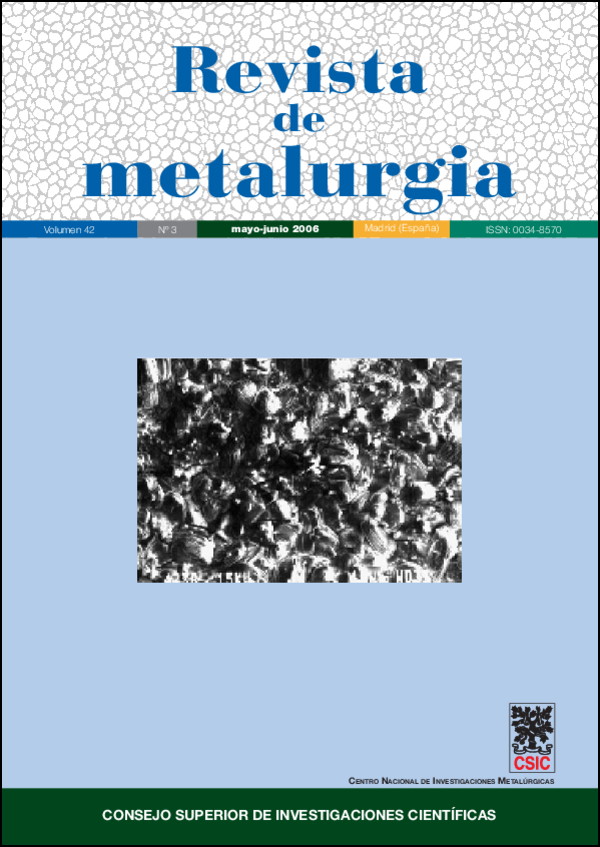Mathematical modeling of mixing phenomena in ladles of aluminum equipped with impeller and gas purging for degassing
DOI:
https://doi.org/10.3989/revmetalm.2006.v42.i3.18Keywords:
Mathematical modeling, Two phase flows, Vortex, Free surface, MixingAbstract
In this work a fundamental Eulerian mathematical model was developed to study fluid flow and mixing phenomena in aluminum ladles equipped with impeller for deshidrogenization treatment. The effect of critical process parameters such as rotor speed, depth of immersion, gas flow rate, and type of rotor on the mixing behavior and vortex formation was analyzed with this model. The model simulates operation with and without gas injection and it was developed on the commercial CFD code PHOENICS 3.4 in order to solve all conservation equations governing the process, i.e. continuity, 3D turbulent Navier-Stokes and the k-e turbulence model for a two-phase fluid flow problem using the Inter Phase Slip Algorithm (IPSA). In order to realistically represent the process, shape of the furnace and three kinds of impellers were drawn by employing Body Fitted Coordinates (BFC). From the results it was concluded that mixing behavior is highly dependent on the rotor speed and on the rotor type. Mixing time is improved when: 1) Impeller is located at a depth of 0.229m into the aluminum bath, 2) By using high rotor speeds, 3) By using ladles with a high aspect ratio of Diameter to Height, and 4)By using an impeller with notches.
Downloads
References
[1] O. M. Suárez, Rev. Metal Madrid 40 (2004) 173-181.
[2] A. Molsalve Y R. Morales, Rev. Metal. Madrid 40 (2004) 431-435.
[3] G. K. Sigworth Y T.A Engh, Metall. Trans. B, 13 September (1982) 442-460.
[4] J. G. Stevens Y H. Yu, Light Metals 1992 Proc. 121st TMS Annual Meeting, San Diego, CA, (USA), 1991, Publ. by Minerals, Metals & Materials Soc. (TMS), Warrendale, PA, USA, pp. 1.023-1.029.
[5] J. F. Grandfield, D.W. Irwin, S. Brumale Y C. J. Simansen, Light Metals 1990 Proc. 119th TMS Annual Meeting, Anaheim, CA, (USA), 1990, Publ. by Minerals, Metals & Materials Soc. (TMS), Warrendale, PA, USA, pp. 737- 746.
[6] M. Nilmani, P.K. Thay Y C.J. Simensen, Light Metals 1992 Proc. of the 121st TMS Annual Meeting, San Diego, CA, (USA), 1991, Publ. by Minerals, Metals & Materials Soc. (TMS), Warrendale, PA, USA, pp. 939-945.
[7] F. Boeuf, M. Rey, Y E. Wuilloud, Light Metals 1993 Proc. of the 122nd Annual Meeting, Denver, CO, USA, 1993, Publ by Minerals, Metals & Materials Soc (TMS), Warrendale, PA, USA, pp. 927-932.
[8] M. Nilmani, P.K. Thay, C. J. Simansen, Y D.W. Irwin; Light Metals 1990 Proc. of the 119th TMS Annual Meeting, Anaheim, CA, (USA), 1990, Publ. by Minerals, Metals & Materials Soc. (TMS), Warrendale, PA, USA, pp. 747- 754.
[9] C. Leroy Y G. Pignault; JOM-J Min. Met. Mat. S. 43 (1991) 27-30.
[10] Y. Ohno, D. T. Hampton Y A. W. Moores; Light Metals 1993 Proc. of the 122nd Annual Meeting, Denver, CO, (USA), 1993, Publ. by Minerals, Metals & Materials Soc. (TMS), Warrendale, PA, USA, pp. 915-921.
[11] M. Maniruzzman Y M. Makhlouf; Light Metals Proc. of the 1997 127th TMS Annual Meeting, San Antonio, TX, (USA), 1998, Minerals, Metals & Materials Soc (TMS), Warrendale, PA, USA, pp. 797-803.
[12] M. Maniruzzaman Y M. Makhlouf; Metall. Trans. B 33 (2002) 297-303. doi:10.1007/s11663-002-0013-6
[13] Dongs, S.T. Johansen Y T.A. Engh; Chem. Eng. Sci. 49 (1994) 3.511-3.518.
[14] G.L. Lane, M.P. Schwarz Y G.M. Evans; Appl. Math. Model. (2002) 223-235. doi:10.1016/S0307-904X(01)00057-9
[15] J. Mietz Y F. Oeters: Steel Res. 59 (1988) 52-56.
[16] Phoenics On-Line Information System (POLIS); PHOENICS 3.4. CHAM Company. 2000.
[17] J. Szekely, Fenómenos de Flujo de Fluidos en Procesamiento de Metales, Ed. Limusa, México, D.F., México, 1988.
[18] B. E. Launder Y D. B. Spalding: Comput. Method. Appl. M. (1974) 269-289.
[19] F. Contreras-Bustos, Tesis de Maestría, Centro de Graduados en Materiales, Instituto Tecnológico de Morelia, 2005.
[20] J. E. Gruzleski Y B. Closset, Treatment of Liquid Aluminum-Silicon Alloys, American Foundry Society; USA, pp. 143-181, 1990.
Downloads
Published
How to Cite
Issue
Section
License
Copyright (c) 2006 Consejo Superior de Investigaciones Científicas (CSIC)

This work is licensed under a Creative Commons Attribution 4.0 International License.
© CSIC. Manuscripts published in both the printed and online versions of this Journal are the property of Consejo Superior de Investigaciones Científicas, and quoting this source is a requirement for any partial or full reproduction.
All contents of this electronic edition, except where otherwise noted, are distributed under a “Creative Commons Attribution 4.0 International” (CC BY 4.0) License. You may read the basic information and the legal text of the license. The indication of the CC BY 4.0 License must be expressly stated in this way when necessary.
Self-archiving in repositories, personal webpages or similar, of any version other than the published by the Editor, is not allowed.
















